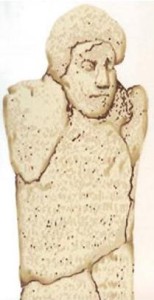The Execration Texts, from 1840 BCE
 Since the time of the Old Kingdom, but especially from the reign of Sesostris III (1800-1840 BCE) onward, scrawled messages in the hieratic script could be found on potsherds, small bowls, and small figurines of men with their arms bound behind their backs, in clay or stone. These were deliberately broken and buried near tombs in Thebes and Saqqara and in a few places in Nubia.
Since the time of the Old Kingdom, but especially from the reign of Sesostris III (1800-1840 BCE) onward, scrawled messages in the hieratic script could be found on potsherds, small bowls, and small figurines of men with their arms bound behind their backs, in clay or stone. These were deliberately broken and buried near tombs in Thebes and Saqqara and in a few places in Nubia.
The content of the inscriptions shows us that this was nothing but a magical practices. The texts were lists of people or things that were regarded as dangerous to the pharaoh and the tomb owner. Dead Egyptians (whose malevolent spirits might be on the prowl) and foreign princes (of Nubia, Libya, and Canaan) were among those named. The foreigners are described as those who might rebel or weave intrigue—they were all feared. The magical theory behind this practice was that by breaking the statuettes and the texts, known as Execration Texts, the person referred to would also be ritually destroyed.
Ratnagar, Shereen, The Timeline History of Ancient Egypt. San Diego- Thunder Bay Press, 2007.



